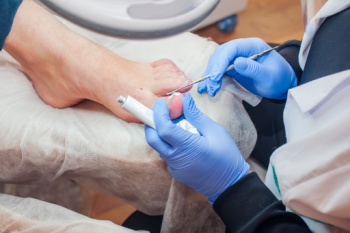
As children grow, their feet and legs constantly change, sometimes leading to alignment problems such as inward or outward turning or flattened arches. These issues can result from differences in bone growth, muscle tightness, or ligament flexibility. Most mild cases improve with age, but some may cause pain, uneven gait, or frequent tripping, if not corrected. A podiatrist can determine whether the condition is part of normal development or needs treatment. Wearing supportive shoes, gentle stretching, and specially designed orthotics can help realign the feet and encourage healthy movement. In certain situations, targeted exercises or braces may be used to guide proper positioning as a child continues to grow. If you notice your child walking unevenly, stumbling often, or showing signs of discomfort, it is suggested that you have their feet evaluated by a podiatrist to ensure healthy development and alignment.
Making sure that your children maintain good foot health is very important as they grow. If you have any questions, contact Barbara J. Aung, DPM of Aung Foot Health Clinic . Our doctor can provide the care you need to keep you pain-free and on your feet.
Keeping Children's Feet Healthy
Having healthy feet during childhood can help prevent medical problems later in life, namely in the back and legs. As children grow, their feet require different types of care. Here are some things to consider...
Although babies do not walk yet, it is still very important to take care of their feet.
Avoid putting tight shoes or socks on his or her feet.
Allow the baby to stretch and kick his or her feet to feel comfortable.
As a toddler, kids are now on the move and begin to develop differently. At this age, toddlers are getting a feel for walking, so don’t be alarmed if your toddler is unsteady or ‘walks funny’.
As your child gets older, it is important to teach them how to take care of their feet.
Show them proper hygiene to prevent infections such as fungus.
Be watchful for any pain or injury.
Have all injuries checked by a doctor as soon as possible.
Comfortable, protective shoes should always be worn, especially at play.
If you have any questions, please feel free to contact our office located in Tuscon, AZ . We offer the newest diagnostic and treatment technologies for all your foot care needs.

Toenail fungus often begins quietly, with nails that lose their shine and become thick, brittle, or yellowed. As the infection progresses, the nail may separate from the bed, crumble, or develop an uneven surface that makes shoes uncomfortable. If ignored, the infection can damage the nail completely and spread to nearby nails or skin. In some cases, the skin beside the nail becomes sore, swollen, or filled with fluid due to a bacterial infection. Because these changes rarely improve without medical attention, prompt evaluation is important. A podiatrist can determine the cause, remove infected tissue, and prescribe targeted antifungal or antibacterial treatments to restore healthy growth. Addressing nail problems early prevents more serious complications. If your toenails look discolored, thickened, or painful, it is suggested that you schedule an appointment with a podiatrist for a diagnosis and professional care.
If left untreated, toenail fungus may spread to other toenails, skin, or even fingernails. If you suspect you have toenail fungus it is important to seek treatment right away. For more information about treatment, contact Barbara J. Aung, DPM of Aung Foot Health Clinic . Our doctor can provide the care you need to keep you pain-free and on your feet.
Symptoms
- Warped or oddly shaped nails
- Yellowish nails
- Loose/separated nail
- Buildup of bits and pieces of nail fragments under the nail
- Brittle, broken, thickened nail
Treatment
If self-care strategies and over-the-counter medications does not help your fungus, your podiatrist may give you a prescription drug instead. Even if you find relief from your toenail fungus symptoms, you may experience a repeat infection in the future.
Prevention
In order to prevent getting toenail fungus in the future, you should always make sure to wash your feet with soap and water. After washing, it is important to dry your feet thoroughly especially in between the toes. When trimming your toenails, be sure to trim straight across instead of in a rounded shape. It is crucial not to cover up discolored nails with nail polish because that will prevent your nail from being able to “breathe”.
In some cases, surgical procedure may be needed to remove the toenail fungus. Consult with your podiatrist about the best treatment options for your case of toenail fungus.
If you have any questions please contact our office located in Tuscon, AZ . We offer the newest diagnostic and treatment technologies for all your foot and ankle needs.

Orthotics are custom-made shoe inserts designed to support and align the feet, improving comfort and overall function. They help correct abnormal walking patterns and relieve pressure caused by plantar fasciitis, flat feet, bunions, and arthritis. By enhancing foot and ankle stability, orthotics can reduce pain, prevent injuries, and improve posture and balance. A podiatrist can perform a detailed evaluation to determine the best type of orthotic for your specific needs, ensuring a precise fit and maximum benefit. Whether for daily wear or athletic activity, orthotics can make a significant difference. If you have a specific foot or ankle condition, it is suggested that you consult a podiatrist for a personalized assessment and expert guidance to see if orthotics are right for you.
If you are having discomfort in your feet and would like to try orthotics, contact Barbara J. Aung, DPM from Aung Foot Health Clinic . Our doctor can provide the care you need to keep you pain-free and on your feet.
What Are Orthotics?
Orthotics are inserts you can place into your shoes to help with a variety of foot problems such as flat feet or foot pain. Orthotics provide relief and comfort for minor foot and heel pain but can’t correct serious biomechanical problems in your feet.
Over-the-Counter Inserts
Orthotics come in a wide variety of over-the-counter inserts that are used to treat foot pain, heel pain, and minor problems. For example, arch supports can be inserted into your shoes to help correct overarched or flat feet, while gel insoles are often used because they provide comfort and relief from foot and heel pain by alleviating pressure.
Prescription Orthotics
If over-the-counter inserts don’t work for you or if you have a more severe foot concern, it is possible to have your podiatrist prescribe custom orthotics. These high-quality inserts are designed to treat problems such as abnormal motion, plantar fasciitis, and severe forms of heel pain. They can even be used to help patients suffering from diabetes by treating foot ulcers and painful calluses and are usually molded to your feet individually, which allows them to provide full support and comfort.
If you are experiencing minor to severe foot or heel pain, it’s recommended to speak with your podiatrist about the possibilities of using orthotics. A podiatrist can determine which type of orthotic is right for you and allow you to take the first steps towards being pain-free.
If you have any questions, please feel free to contact our office located in Tuscon, AZ . We offer the newest diagnostic and treatment technologies for all your foot care needs.






